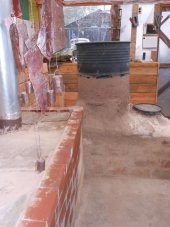posted 7 years ago
You need to have a height difference from feed tube to chimney for draft to work, but I think the main reason for the duct to slope is that you want to encourage the hottest gases to flow along the duct instead of pooling near the source. Bell technology has a large chamber where the gases don't flow in any particular pattern (ideally they become still and only move due to cooling and sinking to the exit, but that is not exactly true in ordinary sized bells); the hottest part of the bell is the top, which can be a tower or a bench shape.
I think it's not the barrel over the riser that causes the forced draft "push", but the riser itself. The barrel only secondarily adds to the draft; its main function is to get the exhaust gases down to bench level. If the core were to be below floor level so the exhaust didn't need to go down from riser top, it would have even stronger draft.








